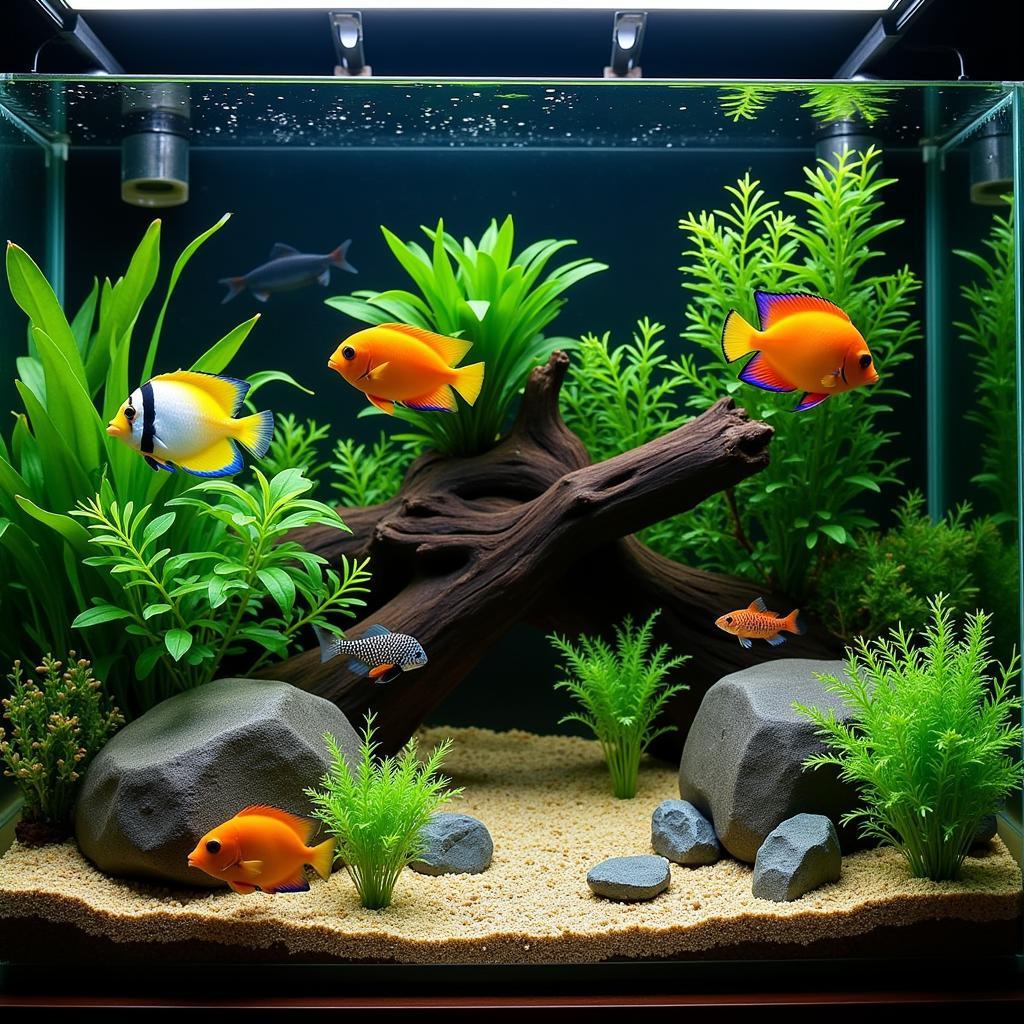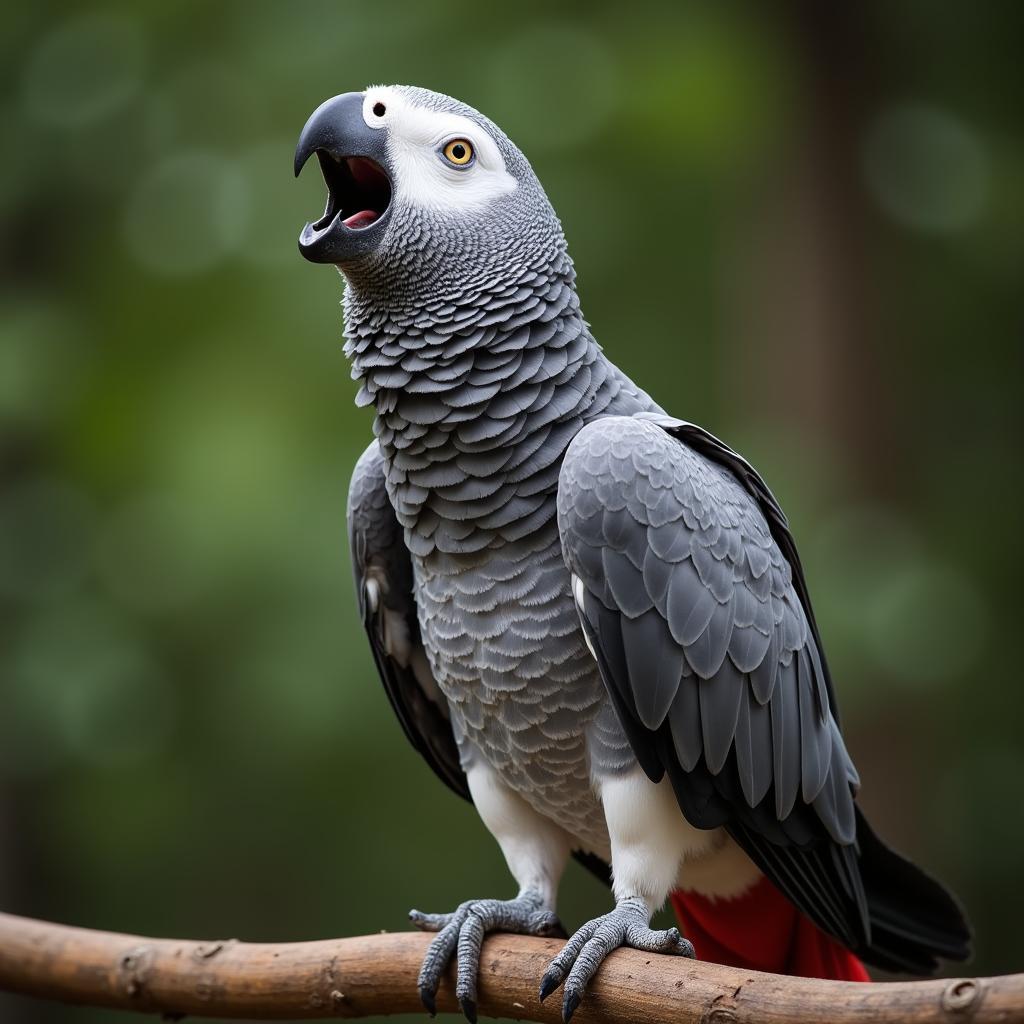African Cichlid Fish Care: A Comprehensive Guide for Beginners
African cichlids are vibrant, fascinating fish known for their diverse colors, unique personalities, and interesting behaviors. They are a popular choice for experienced and beginner aquarists alike, but providing proper care for these fish is crucial for their health and well-being. This comprehensive guide covers everything you need to know about African Cichlid Fish Care, from setting up the perfect tank to understanding their specific needs.
Setting Up Your African Cichlid Tank:
Setting up an appropriate tank for African cichlids is a crucial first step in providing them with a comfortable and stimulating environment. These fish are native to the African Great Lakes, which are characterized by their unique water chemistry, so replicating these conditions in your tank is essential.
Water Parameters:
African cichlids thrive in hard, alkaline water with a pH of 7.5 to 8.5. They are also sensitive to changes in water parameters, so it’s essential to use a water test kit to regularly monitor pH, hardness, and ammonia levels.
Here are the key water parameters to aim for:
- pH: 7.5-8.5
- Hardness: 10-20 dGH
- Temperature: 75-82°F (24-28°C)
- Ammonia: 0 ppm
- Nitrite: 0 ppm
- Nitrate: 20 ppm or less
Tank Size:
African cichlids are active and territorial fish. They require a spacious tank to accommodate their movements and social interactions. A good rule of thumb is to aim for at least 55 gallons for a group of 6-8 medium-sized cichlids, but larger tanks are always recommended for larger species or groups.
Tank Filtration:
Powerful filtration is essential for maintaining water quality in an African cichlid tank. Choose a filter with a flow rate of at least 5 times the tank volume, and consider adding additional filtration, such as a canister filter or a sponge filter, for optimal results.
Substrate:
A sand substrate is ideal for African cichlids, as it mimics their natural habitat and allows them to sift and forage. Avoid gravel or other substrates that may cause mouth injuries.
Decorations:
African cichlids appreciate a variety of rocks, caves, and driftwood. These elements provide hiding places, spawning sites, and territorial boundaries. You can create a realistic African lake environment using a variety of natural rocks, caves, and driftwood.
[shortcode-1]african-cichlid-tank-setup|Cichlid tank setup|This is a photo of a well-stocked African cichlid tank featuring rocks, driftwood, and plants. This setup allows plenty of space for the fish to swim and explore, while also providing hiding spots and breeding areas.
Choosing Your African Cichlids:
African cichlids come in a wide variety of species and color variations. Before selecting your fish, it’s important to research their specific needs and compatibility.
Species Selection:
Research the size, temperament, and water parameters of the species you are considering. Some popular African cichlid species include:
- Mbuna cichlids: These colorful, small-bodied cichlids are known for their aggressive behavior and territoriality. They are best kept in groups of their own species.
- Haplochromine cichlids: Also known as haps, these cichlids are more peaceful than mbuna and can be kept in mixed-species tanks.
- Peacock cichlids: These striking, large-bodied cichlids are known for their impressive color patterns. They can be quite aggressive and should be kept in large tanks with plenty of hiding places.
Compatibility:
Consider the size, temperament, and territoriality of each species when selecting tank mates. It’s important to choose fish that are compatible with each other and can coexist peacefully. Avoid mixing very aggressive species with peaceful species, as this can lead to aggression and stress.
[shortcode-2]cichlid-species-compatibility|African cichlid compatibility|This is a photo showcasing various popular African cichlid species with their distinct color patterns and sizes. The image highlights the diversity of African cichlids and the need for careful species selection to ensure compatibility.
Feeding African Cichlids:
African cichlids are omnivorous and require a balanced diet of both meaty and vegetarian foods. Their diet should consist of high-quality flakes, pellets, frozen foods, and occasional live foods.
Diet:
Here is a sample diet for African cichlids:
- Flakes or pellets: These should form the basis of your cichlid’s diet.
- Frozen foods: Offer a variety of frozen foods, such as brine shrimp, bloodworms, mysis shrimp, and daphnia, 2-3 times a week.
- Live foods: Offer live foods such as mosquito larvae, blackworms, or tubifex worms in moderation.
- Vegetable matter: Include blanched vegetables, like spinach, zucchini, or peas, in their diet once or twice a week.
Feeding Frequency:
Feed your cichlids twice a day, in small amounts that they can consume within a few minutes. Overfeeding can lead to water pollution and health problems.
Maintaining Your African Cichlid Tank:
Maintaining optimal water quality is essential for the health and well-being of your African cichlids. This involves regular water changes, cleaning, and monitoring of water parameters.
Water Changes:
Perform weekly partial water changes of 25-50%, using dechlorinated water that has been allowed to reach room temperature.
Tank Cleaning:
Clean the tank’s substrate and decorations weekly, removing any uneaten food or debris. Clean the filter media as needed, following the manufacturer’s instructions.
Water Parameter Monitoring:
Use a water test kit to regularly monitor pH, hardness, ammonia, nitrite, and nitrate levels. Adjust water parameters as needed to maintain optimal conditions.
[shortcode-3]cichlid-tank-maintenance|African cichlid tank maintenance|This is a photo of a person performing a partial water change in their African cichlid tank. The image emphasizes the importance of regular maintenance for maintaining optimal water quality and health for your cichlids.
Common African Cichlid Diseases:
While African cichlids are generally hardy fish, they can be susceptible to certain diseases if not properly cared for.
Signs of Illness:
Here are some common signs of illness in African cichlids:
- Loss of appetite: If your cichlid refuses to eat, it could be a sign of illness.
- Lethargy: If your cichlid is less active than usual and spends most of its time hiding, it could be sick.
- Abnormal swimming: If your cichlid is swimming erratically or upside down, it could be suffering from a swim bladder issue.
- Fungal infections: White patches on the skin or fins could indicate a fungal infection.
- Parasites: If your cichlid is scratching against objects or has red sores on its body, it could be infested with parasites.
Treatment:
If you suspect your cichlid is sick, it’s important to consult a veterinarian specializing in fish for an accurate diagnosis and appropriate treatment.
Breeding African Cichlids:
African cichlids are known for their fascinating breeding behaviors. If you are considering breeding your cichlids, it’s important to understand their specific breeding requirements.
Breeding Conditions:
African cichlids typically breed in hard, alkaline water with temperatures between 78-82°F (26-28°C). They may display specific breeding behaviors, such as digging a nest or guarding their eggs.
Fry Care:
Once the eggs hatch, the parents will usually care for the fry. However, some species may eat their young, so it’s important to separate the parents from the fry if necessary.
[shortcode-4]cichlid-breeding|African cichlid breeding|This is a photo depicting an African cichlid pair guarding their eggs. The image showcases the fascinating breeding behaviors exhibited by these fish and highlights the importance of providing a suitable environment for successful breeding.
African Cichlid Care Tips:
Here are a few additional tips for caring for African cichlids:
- Don’t overcrowd the tank: Allow enough space for each cichlid to establish its own territory.
- Provide hiding places: Rocks, caves, and driftwood provide hiding places and reduce stress.
- Monitor water parameters: Regularly test your water and adjust parameters as needed.
- Feed a balanced diet: Provide a variety of foods to ensure your cichlids get the nutrients they need.
- Observe your fish regularly: Pay attention to any changes in behavior or appearance, which could indicate a problem.
- Consult a veterinarian if you suspect illness: Seek professional help to ensure your cichlids receive the appropriate treatment.
Conclusion:
African cichlids are beautiful and fascinating fish that can bring a touch of the African Great Lakes into your home. By providing them with the right care, you can create a thriving and stimulating environment where they can flourish. Remember to research specific species and their needs before bringing them home, and always monitor their health and well-being. With proper care, you can enjoy the unique beauty and captivating behaviors of these remarkable fish for years to come.
FAQ:
Q: What are the best tank mates for African cichlids?
A: The best tank mates for African cichlids depend on the specific species and temperament. Peaceful species like haps can be kept with other peaceful cichlids or non-aggressive fish, while more aggressive mbuna cichlids should be kept in species-specific tanks.
Q: How often should I clean my African cichlid tank?
A: You should perform weekly partial water changes and clean the tank’s substrate and decorations. You should also clean the filter media as needed, following the manufacturer’s instructions.
Q: How can I tell if my African cichlid is sick?
A: Signs of illness in African cichlids include loss of appetite, lethargy, abnormal swimming, fungal infections, and parasites.
Q: What should I do if my African cichlid is sick?
A: If you suspect your cichlid is sick, it’s important to consult a veterinarian specializing in fish for an accurate diagnosis and appropriate treatment.
Q: Can I breed African cichlids in a home aquarium?
A: Yes, you can breed African cichlids in a home aquarium. However, you need to provide the appropriate breeding conditions, such as hard, alkaline water and suitable spawning sites.
Q: What are the best foods to feed African cichlids?
A: African cichlids require a balanced diet of both meaty and vegetarian foods. Offer a variety of flakes, pellets, frozen foods, and occasional live foods.
Q: What are some common African cichlid diseases?
A: African cichlids can be susceptible to fungal infections, parasites, and swim bladder issues.
Q: What is the best way to prevent African cichlid diseases?
A: The best way to prevent diseases is to maintain optimal water quality, provide a balanced diet, and observe your fish regularly for any signs of illness.

